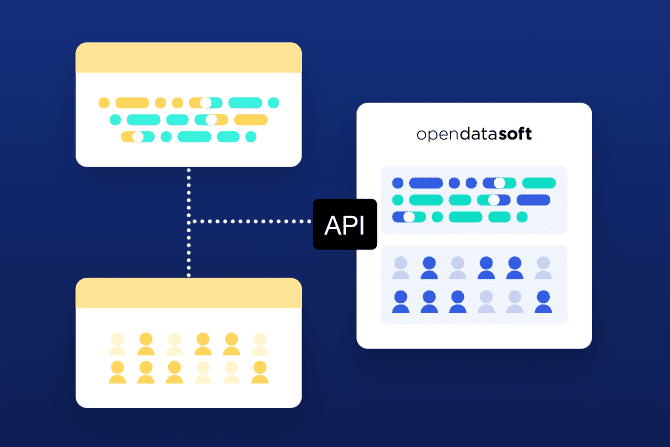Glossary
Data automation
Data automation refers to the practice of processing data through automated software. Essentially, the tasks of collecting, exploring, cleaning or managing data are no longer performed manually by the business, but automatically by computers.
In the age of digital transformation, intelligent data is at the heart of all our actions and decisions. But with increasing volumes of data available, it is more and more difficult to process all available information manually.
Why is this so important for organizations? And how can you automate your data? Find out below.
What is data automation?
Data automation refers to the practice of processing data through automated software. Essentially, the tasks of collecting, exploring, cleaning or managing data are no longer performed manually by the business, but automatically by computers.
To be effective, data automation must take place at all stages of the data value chain, during:
- Extraction: when collecting data from different data sources.
- Transformation: when cleaning and sorting data to ensure its quality.
- Integration: when centralizing data within a single solution, location, or platform to facilitate processing.
- Analysis: once the data’s quality and reliability is checked, it can then be analyzed to deliver value.
- Visualization: in order to facilitate decision-making, data must be accessible and understandable by all. For this, visualization tools can be used, such as dashboards, data stories or graphs.
- Use and/or reuse: data only really brings value when it is used. By facilitating the data process, automation promotes the democratization of data.
The concept of data automation is to optimize the data management workflow within an organization.
What are the benefits of data automation?
Time savings
Before it can deliver maximum value to the organization, data must go through a process to ensure it is properly structured. Because of the multitude of data sources and different formats, data preparation takes time. In fact, data experts say they spend about 80% of the data process preparing data.
But while this phase is vital to allow the data to be fully exploited, it is not a value-creating step. It is therefore crucial to reduce preparation time in order to focus on higher value activities. With data automation, time-consuming and repetitive manual tasks are left to technology, which can automate them quickly and efficiently, following rules set by the business.
Data reliability
Human error is inherent in all manual work. This is especially true when there are tens of thousands of lines of data to explore. With automation, the risk of manual errors is greatly reduced.
Improved decision making
If data analysts, data scientists and other experts spend 80% of their time preparing data, they only have 20% left to devote to their core business: analytics. Yet, it is the analysis of data that allows decision-makers to make the right strategic choices.
With data automation, business experts are able to access reliable data much faster, so they can make decisions in real time, without having to wait for the long process of data verification to be completed.
How can you automate your data process?
To save time at all stages of the data process, it is essential to automate operations. Several features make this easy to achieve.
Automation of connection sources
Data automation starts with efficient data collection. For this, it is possible to use connectors to automatically integrate your data into a single platform. This data automation step requires two essential characteristics:
- Memorizing connections: when new data sets appear from existing sources, you will not have to repeat the process manually.
- Multiple integration: in order to integrate all your data, no matter where it comes from (CRM, business intelligence tools, social networks, website, storage solutions, etc.) you need a solution that offers the maximum number of connectors.
Automate data enrichment
Data enrichment is an essential step but it requires time and expertise. Automation allows you to simplify this step, for example through:
- Field type recognition: to save time when processing data by understanding what type of data is being enriched (such as dates, or addresses).
- Format standardization: for example, you can use ISO 8601 standards to standardize date and time data.
- Data cross-referencing: thanks to automated processors, you can easily combine data that is related to each other, allowing you to enrich the dataset and improve data quality.
APIs
APIs allow users to reuse your datasets easily. This guarantees the quality of the data, which will be automatically updated if a modification is made to the original source.
Check out our article to learn more about the key features to manage and enhance the value chain of your data, from collection to sharing and reuse by other stakeholders.
Learn more

Deploy large-scale data projects with API Automation
To learn about the API’s technical capabilities and the benefits it provides to data portal administrators and the wider organization, we interviewed Coralie Lohéac, Lead Product Manager, and Hugo Bost, Software Engineer, part of the team overseeing the project's development.

3 key collaborative features to engage data consumers with your data portal
How can you break down silos and make data available to everyone within your organization, not just data specialists? How do you get employees to use data effectively in their everyday working lives? This article explains the key features you need on your data portal to engage users and maximize data sharing and reuse.

Accelerating statistical data sharing with SDMX and intuitive data portals
Access to accurate statistical information is key to the successful functioning of the global economy and for policymakers and businesses to make informed decisions around subjects that impact us all. How can institutions effectively and efficiently share their statistical data in an interoperable, scalable way to democratize access and build trust?
